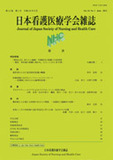Japanese
English
- 有料閲覧
- Abstract 文献概要
- 参考文献 Reference
要旨
本研究は、手のタクティールケアによるリラクセーション効果を検証することを目的に、タクティールケアを施行する[介入]と、ケアをしない[コントロール]を実施し、主観的評価と客観的評価について比較した。その結果、POMSは、[安静①]に比べ[介入]後で「緊張─不安」「抑うつ─落ち込み」「怒り─敵意」「疲労」において有意に得点の減少がみられ、リラックス度は全ての項目において有意に得点が増加した。心拍数とLF/HFは、基準値と比べ[介入]で有意な減少がみられ、分泌型免疫グロブリンA(s-IgA)は有意に増加した。これらの結果より、手のタクティールケアは、リラクセーションに有効であると考える。
Abstract
Purpose: To evaluate relaxation effects of hand tactile care on healthy subjects.
Methods: The 15 young female subjects were invited in this study. The subjects received 20 minutes hand tactile care(Intervention) after 20 minutes sitting position without any intervention(Control). The subjects' heart rates were observed throughout the experiment. The Profile of Mode States(POMS) and the Relaxation evaluation scale as subjective data and low frequency and high frequency heart rate ratios(LF/HF), and salivary secreted immunoglobulin A(s-IgA) as objective data were compared before and after the Intervention and the Control.
Results: The subjects showed significantly lower "Tension-Anxiety," "Depression-Defection," "Anger-Hostility," and "Fatigue" moods and significantly higher relaxation feeling after hand tactile intervention. The heart rates and LF/HF were significantly lowered and s-IgA was significantly increased after the Intervention than after the Control.
Conclusion: Both subjective and objective data showed more relaxation state after the Intervention than the after the Control. These results indicated that the hand tactile care had relaxation effects on the subjects.
Copyright © 2012, Japan Society of Nursing and Health Care All rights reserved.


